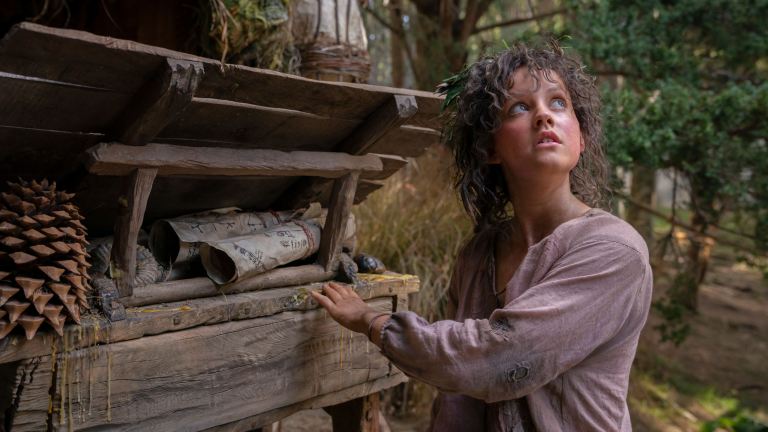The Rings of Power: What Is the Difference Between Harfoots and Hobbits?
The Lord of the Rings introduces Harfoots in The Rings of Power. They look a lot like Hobbits but they're not quite the same...

This Lord of the Rings article contains spoilers for The Rings of Power.
As J.R.R. Tolkien‘s books and the films of Peter Jackson already showed, not all of the races of Middle-earth are preoccupied with dark lords, wars, or magical rings. During the Third Age of The Lord of the Rings timeline, while the Elves, Men, Orcs, Dwarves, and Wizards fight over what to do about Mordor and the One Ring, the little jolly (and lazy) halflings known as Hobbits are mostly back in the Shire, chowing down on massive wheels of cheese, drinking ale, and smoking the finest weed they can get their hands on.
Of course, there are exceptions to every rule, as it was four Hobbits — Frodo, Sam, Pippin, and Merry — along with a fellowship of heroes from the races of Man, Elf, and Dwarf, who embarked on the fateful quest to bring an end to the tyranny of Sauron and Mordor once and for all in The Lord of the Rings books and movies. And even before Frodo carried the Ring of Power, it was his uncle Bilbo Baggins who discovered it deep within the Misty Mountains after it abandoned Gollum, who was once Smeagol, a member of an early Hobbit group known as the Stoors.
So, despite appearances to the contrary, the Hobbits play a very important (and ultimately heroic) role in the history of Middle-earth, but specifically in the Third Age. After all, there weren’t technically any Hobbits as we best know them yet living in their “Hobbit-holes” in the Shire before then.
Where were the Hobbits before they settled in the land of Eriador (where the Shire is located in The Lord of the Rings proper)?
The Harfoots of Rhovanion
The new Amazon prequel series, The Rings of Power, sheds light on the history of another early society of Hobbits known as the Harfoots, who like the aforementioned Stoors of Smeagol fame, don’t yet live in the Shire. During the Second Age, the time period in which the show takes place, the Harfoots live in the land of Rhovanion, east of the Misty Mountains, while the Shire and Eriador are located west of those mountains.
The Harfoots we meet on the show, such as the wise elder Sadoc Burrows (Lenny Henry), haven’t yet adopted the comforts and luxuries that their descendants would later enjoy in the Third Age. These Hobbits are more plainly dressed and live not in lavish homes but in more simple abodes made from trees and plant life. Since they’re much more nomadic at this time, it seems like their more pared down digs are built as such so that they can pick up and leave when they need to. Or disappear when trouble comes too close.
Unlike the sleepy and fat Hobbits of Bilbo and Frodo’s time, the Harfoots are bit more light-footed, hiding from men who roam their lands. For example, we watch in the first episode as two dim-witted hunters trek over a hill, completely ignorant to the fact that they’re walking on the outskirts of an entire Harfoot village. And when one of the hunters thinks he’s heard something rustling in the field below, the other teases him by telling him it might be a Harfoot, which he describes as dangerous magical creatures who are very rarely spotted by their victims…until they attack!
Of course, as the hunters move on, and the cute little Harfoots start popping out from behind bushes and from inside trees and other hidey holes, we know these fairy-like little wanderers couldn’t hurt a fly. But it’s a really interesting bit of worldbuilding in The Rings of Power nonetheless. In the Second Age, Harfoots interact so little with the other races of Middle-earth that they’ve become the subject of a tall-tale that scares full grown men!
From Harfoots to Hobbits of the Shire
But since the Harfoots are predecessors of the Hobbits of the Shire, there are also plenty of similarities between them, like the fact that they live off the land and have a clear respect for it. They also love food, such as the berries the little Harfoot children stuff into their mouths by the fistful, and for the most part like to stay out of conflict or the larger concerns of the kingdoms of Middle-earth.
The Rings of Power also draws a clear throughline between the Harfoots and the Hobbits of the Third Age with one character’s name: Elanor Brandyfoot, played by Markella Kavenagh. Brandyfoot is of course very close to “Brandybuck,” one of the oldest families of the Shire of which Dominic Monaghan’s Meriadoc is a member. Now, in Middle-earth lore, the Brandybucks are most directly descended from the Stoors, but they also connect back to the Fallohides, the third major Hobbit predecessors. Since Elanor, called “Nori” by her family and friends, is an original character created for the show, it’s possible the writers have retconned Brandybuck history a little bit for the easter egg.
But when in Middle-earth history did the Harfoots become the Hobbits of the Shire? According to Tolkien’s extensive writings on the history of his fictional world, the Harfoots were the first of the three Hobbit groups to travel west and into Eriador in the Third Age, settling as far as Bree, a village just east of what would become the Shire. The Stoors and Fallohides eventually joined them west, and together they settled in the lands where our beloved Hobbits live a very cozy existence in The Lord of the Rings.
Yet, in the time of The Rings of Power, the Harfoot migration west is not for many centuries yet, which means we’re bound to see these little halflings frolicking through some unfamiliar parts of Middle-earth and places we’ve never actually seen on screen before!
The Lord of the Rings: The Rings of Power is out now on Amazon Prime Video.
